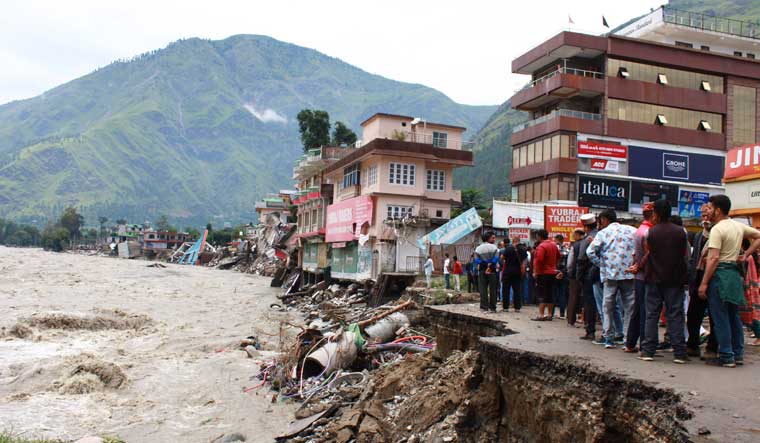Manali Flash Floods: A Disaster That Has Been Brewing For Ages
Jul 14, 2023 | Shalini Rai
People stand by a road washed away by the River Beas swollen due to heavy rains in Manali, Himachal Pradesh (Image: AP)
Events of last week have acquired a mythic sheen on account of the prescience and wilful ignorance of that prognostication. Visuals of the swollen, almost angry Beas river sweeping up and along everything in its path; houses, ATMs, hotel and restaurants falling like a pack of cards and being devoured by muddy waters; wooden logs, debris and silt first floating along with the water and then being deposited on iron bridges, as if nature vacuumed it all; cars bobbing away, buses being swept along and trucks floating on rivers and overflowing streams like a set of lego blocks — all this and much similar imagery has defined the situation of the past few days in Himachal Pradesh, in general and the hill station of Manali, in particular.
I have had a long association with Himachal and Manali — it goes back to the 1980s, when I first visited the Himalayan state for a nature-study-cum-trekking expedition to Raison, near Kullu. At the time, the area was vastly different from today. Our camp was beside the Beas river — a few white tents for accommodation and another few for ablutions etc. The river water was clear and clean. Vehicular movement was sparse and one could truly feel like being in the “lap of nature” — something that is simply not true anymore.
The rampant urbanisation that we have seen in recent years, in the area, was simply not imaginable in the 80s. However, with the rise of militancy in Jammu and Kashmir and much of Himachal still pristine, it was not long before tourist traffic began to be diverted south-eastwards, leading to slow but lasting changes in the character and composition of a once-hill town into an urbanised high altitude mess.
One of the foremost reasons for the current state of Manali is unchecked construction using cement and concrete. The other is permission given by or wrested from authorities to construct multi-storey building on steep slopes, unstable surface and sometimes, right on the edge of the river bank. Those incredible visuals we have all seen by now are mainly because of this unregulated urbanisation in a fragile hill town.
The other is greed and myopia. At a presentation given to top-ranking bureaucrats of the state in 2013, this author had pointed out how Manali was sitting on a powder-keg of imminent, large-scale catastrophe if urgent steps were not taken. From waste management and disposal to stricter regulation of new construction and traffic in the hill station, a lot of issues were brought up and discussed. The end result was disappointing. The stakeholders — taxi operators, hotel and restaurant owners, serving and former government officials, teachers and tour and travel companies — were simply not ready to take the immediate steps that were essential to prevent and pre-empt impending disaster.
It does not feel good to say “I told you so…” Yet, that is how the situation in Manali has turned out to be. It has not happened in a day, however. The past few years have seen monsoon rains delivering warning signs to residents and tourists alike. The Aaloo Ground has been systematically eroded, with a larger and larger area being chipped away by the Beas during the rainy season. Yet, myopic taxi unions and callous bus owners have simply not heeded the calls to self-regulate.
The same holds true for resorts, hotels, restaurants or pop-up cafes built near, next to or sometimes right on the Beas river, from Burwa to Raison and beyond. Any construction on or next to a volatile water body can only be termed ecological hara-kiri and myopic beyond belief.
A lot of presumptions we have had about modern living and travel have come undone in the past few incredible days. One of them is the omnipresence and seeming predominance of electronic devices and e-payment protocol. With heavy rains disrupting electricity, which led to low (or no) battery and subsequent collapse of UPI payment methods, tourists and travellers were reminded yet again of just how frangible our existence and the various accoutrements we have acquired are. With no ATM access, no mobile or net payments and no cash, tourists stranded in Himachal in recent days have highlighted the fragility and ‘short-termness’ of our urban constructs and paraphernalia.
In a conducive scenario, lessons will be learnt and a repeat of this man-made disaster will be prevented. But given past actions and the stubborn tendency to not learn from the past, I am not too hopeful, either for Manali or for other ‘popular’ places in the Himalayas.
